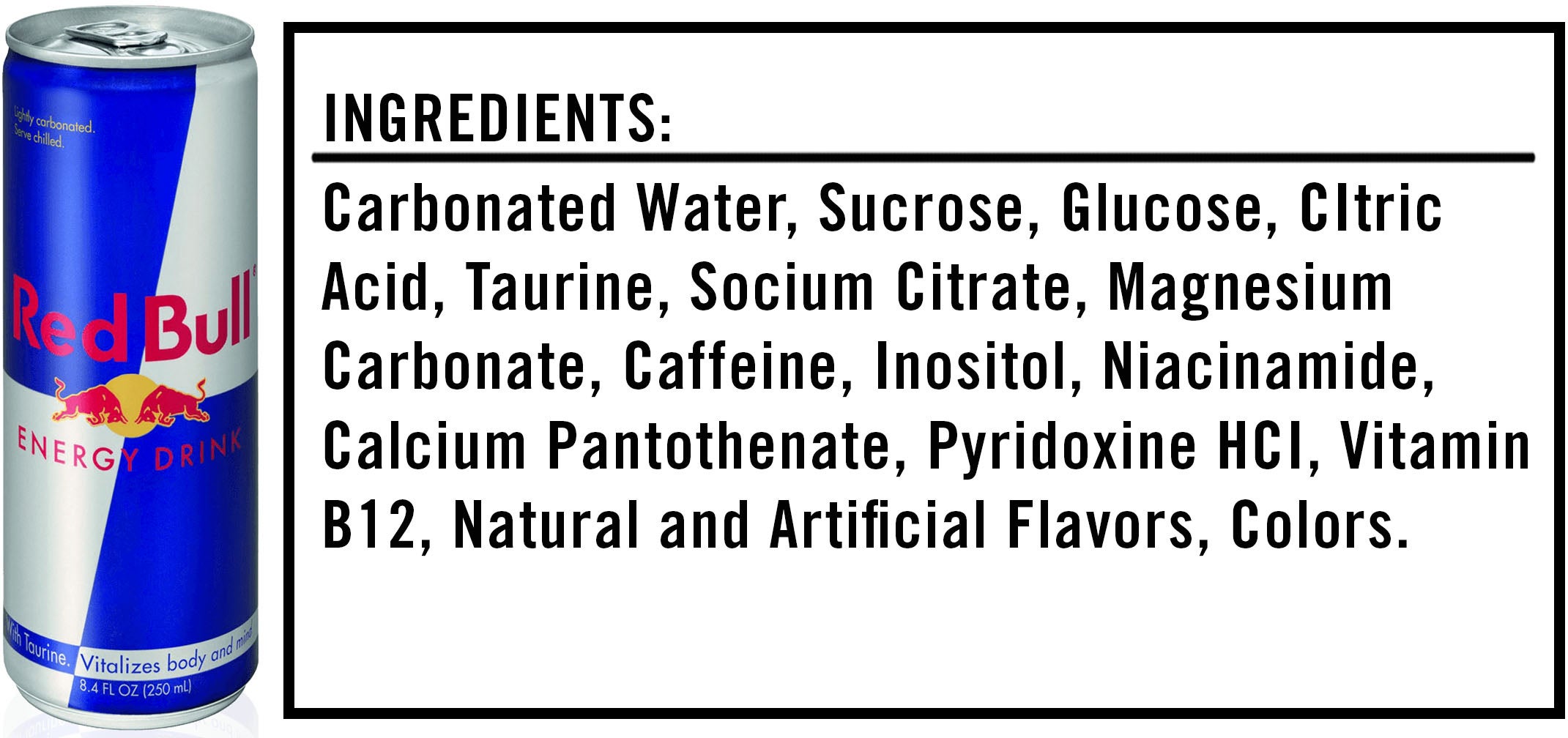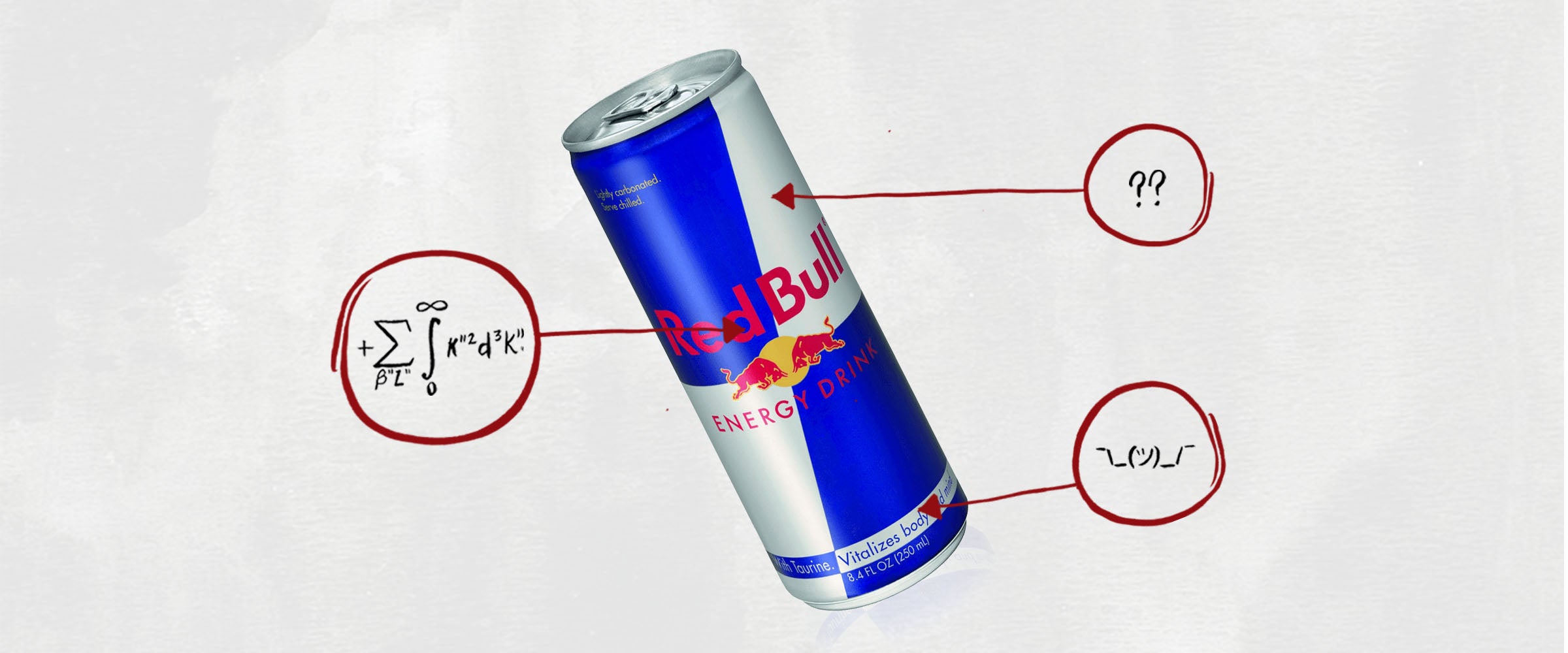We’re often told that you should never eat anything (or put anything on your body) if you don’t recognize everything on the ingredients list. But since most of us have no idea what xanthan gum or potassium benzoate are — or more importantly, what they’re doing to our bodies — we’re decoding the ingredients in the many things Americans put in (and on) themselves with the help of an expert.
This edition: Red Bull, which is made from 15 separate ingredients that we’ve broken down in the exact order they appear on Amazon, since the ingredients aren’t listed in full on the Red Bull website. This ingredients list also doesn’t include the vodka you will inevitably add.

The Ingredients
1) Carbonated Water: This ingredient is probably better known as soda water, sparkling water or seltzer water. Whichever name you prefer, it’s just water that’s had carbon-dioxide bubbles added for fizziness.
2) Sucrose: Sucrose is just a fancy term for table sugar, which is bountiful in Red Bull: An 8.4-ounce can contains 27 grams of sugar, or the equivalent of an entire Snickers bar. For reference, the American Heart Association recommends men consume no more than 36 grams and women consume no more than 25 grams of added sugar a day (and that doesn’t include sugar found naturally in foods like fruits and vegetables).
3) Glucose: Glucose is a simple sugar commonly derived from corn starch.
4) Citric Acid: Citric acid is a sour flavoring agent derived from citrus, and it’s often used to make products like Red Bull practically immortal, with no major quality drop no matter how long they’re sitting on the shelves.
5) Taurine: Taurine is an essential amino acid, and some studies have found that it improves mental performance when combined with caffeine. Taurine also appears to be the catalyst behind the ongoing rumor that claims Red Bull contains bull semen, which was debunked (thank God) by Snopes:
“The composition of that substance’s name — ‘taur’ being a Greek/Latin root for ‘bull,’ and the ‘-ine’ suffix denoting something derived from the preceding root — suggests to the casual observer that taurine is something made or excreted by a bull, possibly something like ‘bull urine.’”
6) Sodium Citrate: Sodium citrate is the sodium salt of citric acid (a sour flavoring agent and preservative derived from citrus). It acts as a preservative and can provide a sour taste when added in high amounts.
7) Magnesium Carbonate: Magnesium carbonate has many uses, but as a food additive, it can be used to regulate acidity and help foods and drinks maintain their colors.
8) Caffeine: An 8.4-ounce can of Red Bull contains 80 milligrams of caffeine — about the same as a similarly sized cup of coffee — which actually isn’t that much compared to some other energy drinks.
9) Inositol: This B vitamin might help balance certain chemicals in the body to reduce symptoms of various mental conditions (like panic disorder, depression and obsessive-compulsive disorder).
10) Niacinamide: This B vitamin improves cholesterol levels and lowers cardiovascular risks.
11) Calcium Pantothenate: This B vitamin helps our body convert fats, carbohydrates and proteins into energy.
12) Pyridoxine HCI: This helps the brain create serotonin (which regulates mood) and norepinephrine (which helps the body cope with stress).
13) Vitamin B12: This keeps nerve and blood cells healthy. Low levels of vitamin B12 have also been associated with premature ejaculation, so Red Bull surprisingly might not be the worst choice if you’re dealing with that.
14) Natural and Artificial Flavors: While natural flavors are literally flavors derived from an actual food source — i.e., lemon flavoring taken from a real lemon — artificial flavors are chemical compounds created in a lab that mimic a natural flavor in some way. While that may sound unhealthy, as physician and biochemist Cate Shanahan, author of Deep Nutrition: Why Your Genes Need Traditional Food, told us during our exploration of all 26 ingredients in nacho-flavored Doritos, these flavorings are added in such small quantities that they shouldn’t cause you any harm.
15) Colors: Artificial colors have a bad reputation, but as Shanahan also explained during our analysis of Doritos, studies arguing this are a bit flawed: “I’ve always been of the opinion that studies claiming artificial colors can cause cancer are irrelevant because [in the studies] they use really high amounts of the artificial colors — like, a million times more than you’d ever get [in your] food [throughout your lifetime].”
All in all, the average person’s liver should be able to break down whatever minuscule amount of artificial coloring we consume with food and drink.
The Takeaway
Red Bull might actually not be all that bad for you if it weren’t for the 27 freaking grams of sugar, which you can admittedly avoid by drinking sugar-free Red Bull (although that contains artificial sugars, which come with their own set of problems). At the end of the day, you’re much better off drinking black coffee if you need a caffeine fix. Depending when you drink it, that is. And so long as you don’t shove it up your ass.

